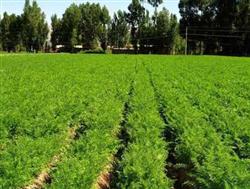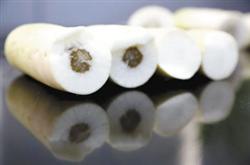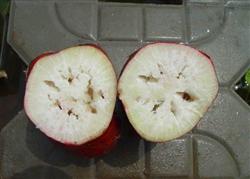Cultivate carrots in early spring

Select suitable varieties to select spring sowing varieties with bolting resistance, short growth period, heat resistance in later stage, good appearance and internal quality, neat root shape, few abnormal roots and high yield, such as Heida Wucun and Chunshijin introduced from abroad. Domestic varieties such as Hongxin No. 5 and Chunhong No. 1. The new seed carrot seed belongs to the short-lived type, the seed storage time is too long, the vitality will decrease, resulting in the carrot plant growth weakening, encounter slightly hard soil will be bifurcated. Therefore, new seeds harvested in the previous year or canned seeds during the shelf life should be selected to prevent the formation of bifurcated or malformed roots. Strictly control the sowing time is too early, the seedling stage is exposed to low temperature for too long, easy to bolting in advance; sowing too late, high temperature in the later stage, low yield, poor coloring, many malformed roots, poor marketability. Generally speaking, it is necessary to sow seeds as early as possible when the daily average temperature is 6: 8 ℃. The inland areas of Shandong should sow seeds from mid-late March to early April. The cultivation in small arch shed can be advanced from late February to early March. The root vegetable crops of carrot in loose and fertile land should be planted in sandy loam or loam soil with deep soil layer, loose and fertile soil, good drainage, leeward, early heating, good water permeability and air permeability as far as possible. in order to facilitate root expansion, coloring, improve quality and commodity rate. Try not to choose clayey land for planting. Deep ploughing and fertilization, fine soil preparation of cultivated land every 667 square meters of rotten barnyard manure 3000-4000 kg, phosphorus and potassium compound fertilizer 30 kg, available nitrogen fertilizer 10 kg as base fertilizer. It is necessary to plough 25cm deep and rake fine. To ridge planting, it can be planted in one row or in two rows. Single-row planting ridge width 50, 20 cm high; double-row planting ridge 70 cm wide, 20 cm high, row spacing 17 cm. Can also carry out flat planting, such as the use of flat planting, border width of 1.5 to 1.7 meters, border ridge width of 30 cm. Seed soaking to accelerate germination is generally 667 square meters with seed 500 grams 750 grams. Carrot seeds are not easy to absorb water and air, coupled with spring sowing temperature and ground temperature are low, seed germination and emergence is slow. Seed soaking can be carried out to accelerate germination. Specific methods: 4-5 days before sowing, soak the seeds in warm water of 30 ℃ for 4 hours, remove them and put them in a wet cloth bag, put them into a 20-25 ℃ to promote germination, keep the seeds moist and turn regularly to make the temperature and humidity uniform. Most of the seeds can be sown after they are exposed to white. Sowing method in order to sow evenly, the seeds can be mixed into 3 times 4 times the fine soil. Ridging cultivation should adopt strip sowing, first open the ditch, ditch depth 3~4cm, irrigate the bottom water along the ditch to make soil moisture, wait for the water to seep into the soil, cover the soil 2 cm thick, and then cover with plastic film, in order to increase the temperature and preserve soil moisture. The flat bed should be watered first and sown after the water seeps into the soil. If sowing, cover soil 2 cm thick after sowing, smooth; if sowing, trench according to row spacing of 17 cm, ditch depth of 2 cm, smooth after sowing, cover with plastic film. When using small plastic arch shed for cultivation, plastic film should be covered with plastic shed immediately, so as to increase the ground temperature as much as possible and promote seedling emergence. Field management and time seedlings, fixed seedlings, plant spacing of 10 cm to 15 cm. Before closing ridges, ploughing should be done to preserve soil moisture, and the fine soil should be cultivated to the root head to prevent the root head from being exposed to the ground to form a green shoulder. Weeding is the key to the high yield of carrots. Herbicides can be used to control weeds. 100 grams of 50% chlorpromazine wettable powder is used every 667 square meters, 25 kilograms of water, and the soil surface is sprayed before emergence after sowing. Pay attention to scientific fertilizer and water management throughout the growing period. The common diseases for disease control are: black rot, black spot, Sclerotinia sclerotiorum and so on. At the initial stage of the disease, 72% Kelu 750 times solution or 52.5% Yikuangjing dispersible powder 2000 times solution can be used to control the disease, once every 5 to 7 days, twice in a row. When the fleshy root of timely harvested carrots reaches the harvest maturity, the heart leaves are generally yellowish green and the outer leaves are slightly withered and yellow, so they should be harvested in time. The specific harvest time also varies with sowing time and varieties. Those sown in small arch sheds from late February to early March are generally harvested in the first and middle of June, and those sown from mid-late March to early April are generally harvested from mid-late June to early July.
- Prev

There are three fears in growing radish
The root epidermis of radish appears horizontal filamentous black lines and becomes rough, and the internal tissue changes color and deteriorates in severe cases. The main reasons are lack of boron, excessive chloride ion, high groundwater level, poor drainage, and the application of undermature fertilizer. Therefore, planting in low-lying land should be avoided; no or less chlorine-containing compounds should be applied, and boron fertilizer should be increased. ...
- Next

Causes and countermeasures of bran heart of radish in early spring
The heart of radish bran is also called hollow, that is, the hollow phenomenon occurs in the central part of the xylem of the fleshy root. 1. The causes are as follows: (1) it is related to variety. For the varieties with large parenchyma cells of fleshy roots, the density of fleshy roots is poor, and bran hearts are easy to appear. (2) related to soil quality. Radish cultivated in sandy soil is better than in loam or clay.
Related
- Where is it suitable to grow horseradish in China? it is expected to see the middle altitude horseradish in Alishan.
- How to prevent tomato virus disease reasonably? (Control methods included)
- Many people like to plant towel gourd on the balcony. What are the main points of this method and management?
- What crops can chili peppers be mixed with?
- Fertilization techniques and matters needing attention in Tomato
- What are the grafting techniques for peach seedlings in spring?
- Harm and control methods of root swelling disease of Chinese cabbage
- What are the pests of sweet potatoes? How to prevent and cure it?
- Symptoms, causes and Control methods of navel Rot in Tomato
- The cause of "Cucumber rotten bibcock" in Farmers' planting Cucumber and its Control Plan

